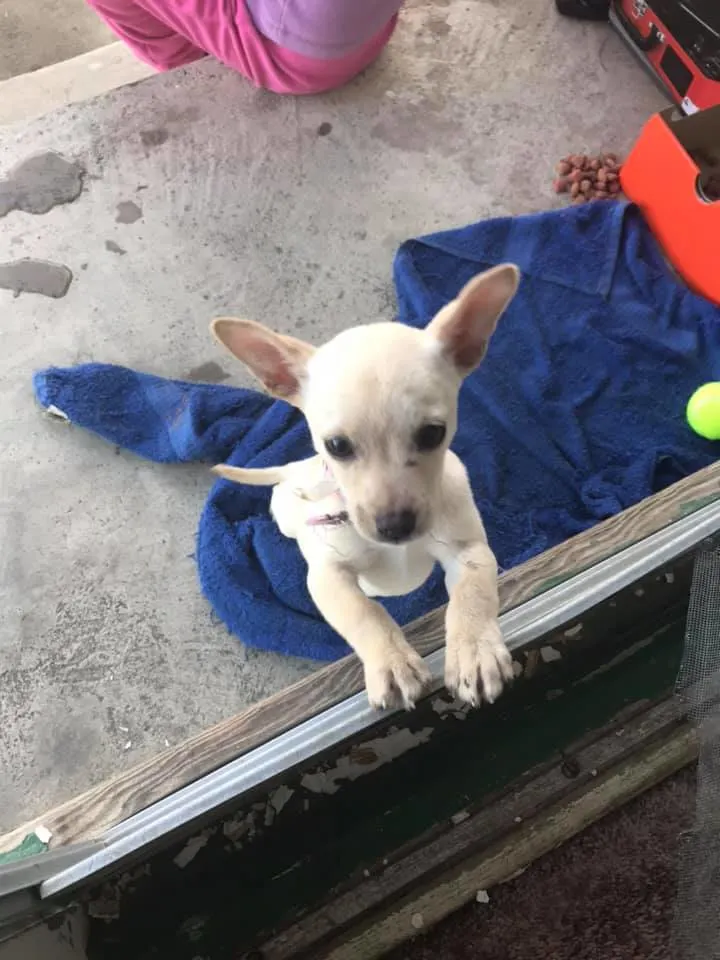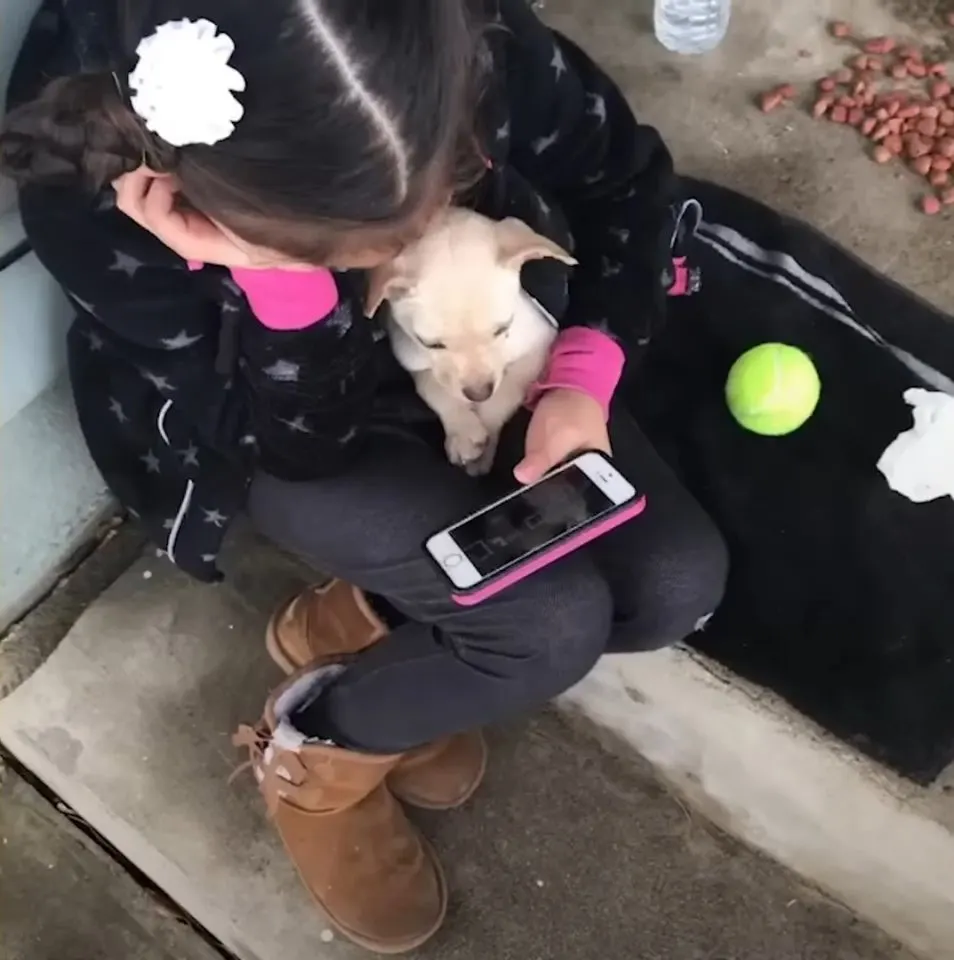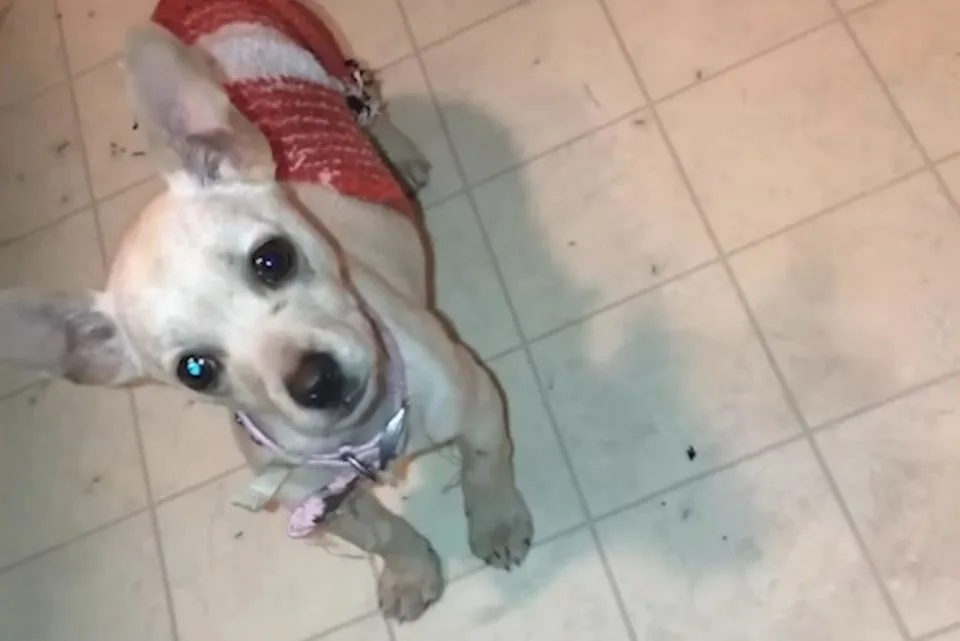It was a rainy day outside when a young teenager named Ubaldo Apolinar, from Selma, California, heard scratching on his front door.
When he went to investigate, he found a small puppy sheltering from the rain on his porch. With a deep sense of responsibility and a desire to ensure the safety of the lost puppy, he tried to get it inside, but his parents wouldn’t allow it.
However, that didn’t stop this compassionate young man from taking care of the poor puppy.
Shivering In The Rain

Seeing this poor puppy shivering in the rain, Ubaldo immediately went to get some of his own dog’s food to give it to her.
“At first, she backed away a little bit, but I kept getting closer to her, and once I pet her, she basically trusted me,” Ubaldo told The Dodo.
He had no idea where this little dog came from, but as a dog owner himself, he wanted nothing more than to help her.
She still had a pink collar around her neck, so he assumed that she was lost and that her owners were looking for her.
He joined various community groups on Facebook and posted about the lost puppy, hoping that the owner would see it.
While he waited for someone to contact him, he made sure that the puppy was well-fed and cleaned.
He even asked his parents if the puppy could stay there, but his parents said she couldn’t. They already had a dog named Rocky and the landlord only allowed them to have one pet.

“My sister and I hung out with her out on the porch in the afternoon, and then we played with her […] I was worried about her being outside in the cold at night, so I made a little house for her out of an old cardboard box. But I couldn’t stop thinking about her at night, so I just snuck her in while my parents were asleep,” Ubaldo said.
He quickly took her to the bathroom where he played with her and tried to keep her quiet. He even made her a makeshift sweater out of an old sock.
“I was getting attached to her. I wish I could have kept her, but I knew the right thing to do was to take her back to her owners,” Ubaldo said.
Finding Her Way Home

Eventually, he got caught by his parents, but it all didn’t matter because the very next day, Ubaldo got a message from the potential owner.
“I got a potential owner request and after light social media stalking and passing by her house, her story checked out,” Ubaldo said.
The potential owner lived in Selma, CA, as well… not too far from Ubaldo’s house.
They made plans to meet the same day, so he could return the dog to them.
“Right before I returned her, I played with her one last time in the yard with the tennis ball she liked to play with, and I enjoyed the time with her. She was very fun to hung out with. She was very spunky and adorable,” Ubaldo said.
Eventually, it was time to return the dog to his home. The owner’s daughter came out and told him the dog’s name was Bubba.
After all the trouble, Bubba was finally home where she belonged.
Luckily, Bubba doesn’t live far away, and her new friend, Ubaldo, can visit her any time!
Watch Bubba’s journey from being lost to finding her way home:
Ever noticed your furry friend gleefully rolling in something less than pleasant? It’s a common sight that can leave you puzzled. Dogs’ affinity for rolling in dead animals might seem bizarre, but there’s a fascinating explanation behind this quirky behavior. As a seasoned dog trainer, you’ve likely encountered this curious habit more than once.
Picture this: you’re out for a stroll with your canine companion, and suddenly, they find a deceased critter and decide it’s the perfect spot for a roll. It’s a behavior that can leave you scratching your head, but understanding the reasons behind it sheds light on the intriguing world of canine instincts.
Understanding the Canine Psyche
The Instinctual Explanation
When your furry companion rolls in a dead animal, it may seem puzzling, but it’s all about instinct. Dogs have a strong sense of smell, and by rolling in the scent of a deceased animal, they’re essentially masking their own odor. This behavior harks back to their wild ancestry when camouflaging their scent helped them hunt prey or avoid predators. So, next time you catch your dog in this act, remember, it’s just their natural instinct at play.
A Historical Perspective
Looking at this behavior from a historical lens, we see that dogs have retained many of their ancestors’ survival instincts. Rolling in dead animals could be seen as a way for dogs to blend in with their surroundings, making them less detectable to potential threats. In the wild, this behavior could have been crucial for their survival. While domesticated dogs may not need this camouflage, the instinct remains ingrained in their genetic makeup, showing that even our modern-day companions carry traces of their wild past.
The Science Behind the Behavior
Masking Their Scent
When dogs roll in dead animals, they’re not just trying to gross you out – it’s all about survival. By covering themselves in the scent of a deceased animal, your furry friend is tapping into their wild instincts. This behavior dates back to when dogs needed to hide their own smell while hunting or escaping predators in the wild. Even though your pet may lead a pampered life now, those ancient survival skills are still a part of their DNA.
Communication with the Pack
Rolling in dead animals might seem bizarre to us, but it’s all about sending a message to their pack. In the wild, dogs would cover themselves in scents to communicate with other members of their group. By rolling in a deceased animal, your pet is essentially broadcasting information to their fellow four-legged friends. It’s their way of sharing news, marking territory, and bonding with their pack mates. So, the next time your dog comes back smelling less than fresh, remember, they’re just trying to connect with their inner wild side.
Health Concerns and Risks
Potential Parasites and Diseases
When your furry friend decides to roll in something less than pleasant, like a deceased animal, there’s more to worry about than just the stench. This behavior can expose them to potential parasites and diseases that may be present in the carcass. Dogs can pick up ticks, fleas, or bacteria that can lead to infections. It’s essential to keep an eye on any changes in your dog’s behavior or health after such an incident.
How to Discourage the Behavior
Consistent Training Methods
Training your dog consistently is key to discouraging the behavior of rolling in dead animals. Reinforce commands such as “leave it” or “come” during walks to redirect their attention away from carcasses. Positive reinforcement through treats or praise for obeying commands can help deter this instinctual behavior.
Alternative Scents and Diversions
Introduce alternative scents and diversions to distract your dog from rolling in dead animals. Using citronella-based products or essential oils that dogs find unpleasant can help create a deterrent. Additionally, offering engaging toys or interactive play during walks can shift their focus from scavenging to playful activities.
Conclusion
So, there you have it – dogs rolling in dead animals isn’t just a random act. It’s all about their instinctual need to communicate and bond with their pack. Remember, this behavior can come with some health risks, so keeping an eye on your furry friend’s well-being is important. By using consistent training techniques and introducing alternative scents or distractions, you can help steer your dog away from those not-so-pleasant encounters. Just stay vigilant, and your pup will be rolling in joy for all the right reasons!
Frequently Asked Questions
Why do dogs roll in dead animals?
Dogs roll in dead animals as a behavior inherited from their wild ancestors. This action is linked to their instinctual need for communication and bonding within their pack.
What risks do dogs face when rolling in dead animals?
Rolling in dead animals can expose dogs to health risks such as parasites and diseases due to the decomposition process.
How should I monitor my dog’s health after rolling in a dead animal?
Regularly observe changes in your dog’s behavior, appetite, and overall health post rolling in a dead animal. Consult a veterinarian if you notice any concerning symptoms.
What training methods can discourage dogs from rolling in dead animals?
Consistent training methods like reinforcing commands such as “leave it” or “come” can help deter dogs from rolling in dead animals.
How can I redirect my dog’s attention from dead animals during walks?
Introduce alternative scents or distractions like citronella-based products or engaging toys during walks to redirect your dog’s focus away from carcasses.
[no_toc]

Hey there, I’m Janet Brooks, a dog-loving student from California. I’m all about helping pups in need, especially those without homes. Me and my awesome friends work together to give shelter and love to stray dogs. Oh, and I also write blogs about dogs to share helpful info.